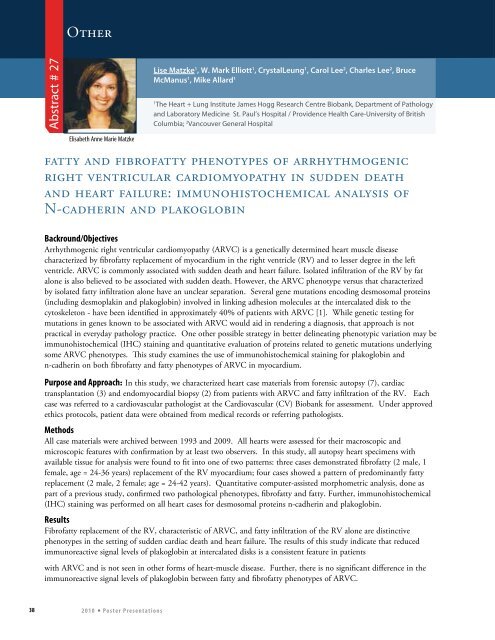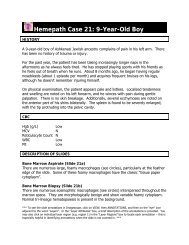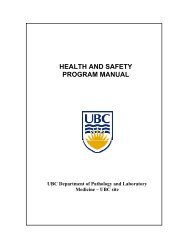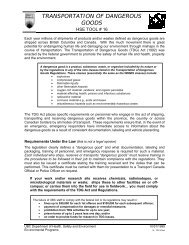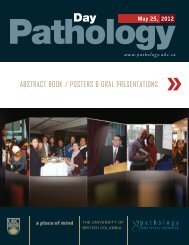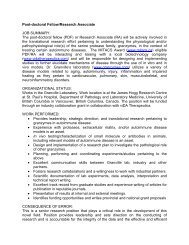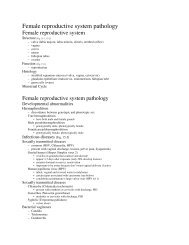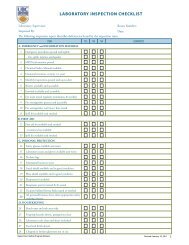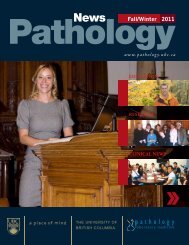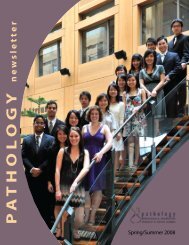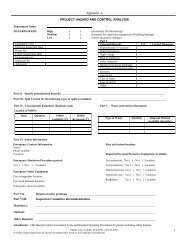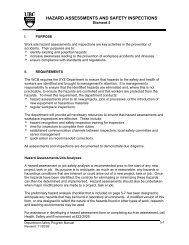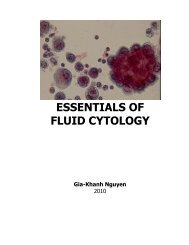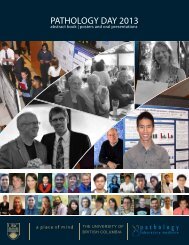Oral Presentations - Pathology and Laboratory Medicine - University ...
Oral Presentations - Pathology and Laboratory Medicine - University ...
Oral Presentations - Pathology and Laboratory Medicine - University ...
You also want an ePaper? Increase the reach of your titles
YUMPU automatically turns print PDFs into web optimized ePapers that Google loves.
OtherAbstract # 27Lise Matzke 1 , W. Mark Elliott 1 , CrystalLeung 1 , Carol Lee 2 , Charles Lee 2 , BruceMcManus 1 , Mike Allard 11The Heart + Lung Institute James Hogg Research Centre Biobank, Department of <strong>Pathology</strong><strong>and</strong> <strong>Laboratory</strong> <strong>Medicine</strong> St. Paul’s Hospital / Providence Health Care-<strong>University</strong> of BritishColumbia; 2 Vancouver General HospitalElisabeth Anne Marie Matzkefatty <strong>and</strong> fibrofatty phenotypes of arrhythmogenicright ventricular cardiomyopathy in sudden death<strong>and</strong> heart failure: immunohistochemical analysis ofN-cadherin <strong>and</strong> plakoglobinBackround/ObjectivesArrhythmogenic right ventricular cardiomyopathy (ARVC) is a genetically determined heart muscle diseasecharacterized by fibrofatty replacement of myocardium in the right ventricle (RV) <strong>and</strong> to lesser degree in the leftventricle. ARVC is commonly associated with sudden death <strong>and</strong> heart failure. Isolated infiltration of the RV by fatalone is also believed to be associated with sudden death. However, the ARVC phenotype versus that characterizedby isolated fatty infiltration alone have an unclear separation. Several gene mutations encoding desmosomal proteins(including desmoplakin <strong>and</strong> plakoglobin) involved in linking adhesion molecules at the intercalated disk to thecytoskeleton - have been identified in approximately 40% of patients with ARVC [1]. While genetic testing formutations in genes known to be associated with ARVC would aid in rendering a diagnosis, that approach is notpractical in everyday pathology practice. One other possible strategy in better delineating phenotypic variation may beimmunohistochemical (IHC) staining <strong>and</strong> quantitative evaluation of proteins related to genetic mutations underlyingsome ARVC phenotypes. This study examines the use of immunohistochemical staining for plakoglobin <strong>and</strong>n-cadherin on both fibrofatty <strong>and</strong> fatty phenotypes of ARVC in myocardium.Purpose <strong>and</strong> Approach: In this study, we characterized heart case materials from forensic autopsy (7), cardiactransplantation (3) <strong>and</strong> endomyocardial biopsy (2) from patients with ARVC <strong>and</strong> fatty infiltration of the RV. Eachcase was referred to a cardiovascular pathologist at the Cardiovascular (CV) Biobank for assessment. Under approvedethics protocols, patient data were obtained from medical records or referring pathologists.MethodsAll case materials were archived between 1993 <strong>and</strong> 2009. All hearts were assessed for their macroscopic <strong>and</strong>microscopic features with confirmation by at least two observers. In this study, all autopsy heart specimens withavailable tissue for analysis were found to fit into one of two patterns: three cases demonstrated fibrofatty (2 male, 1female, age = 24-36 years) replacement of the RV myocardium; four cases showed a pattern of predominantly fattyreplacement (2 male, 2 female; age = 24-42 years). Quantitative computer-assisted morphometric analysis, done aspart of a previous study, confirmed two pathological phenotypes, fibrofatty <strong>and</strong> fatty. Further, immunohistochemical(IHC) staining was performed on all heart cases for desmosomal proteins n-cadherin <strong>and</strong> plakoglobin.ResultsFibrofatty replacement of the RV, characteristic of ARVC, <strong>and</strong> fatty infiltration of the RV alone are distinctivephenotypes in the setting of sudden cardiac death <strong>and</strong> heart failure. The results of this study indicate that reducedimmunoreactive signal levels of plakoglobin at intercalated disks is a consistent feature in patientswith ARVC <strong>and</strong> is not seen in other forms of heart-muscle disease. Further, there is no significant difference in theimmunoreactive signal levels of plakoglobin between fatty <strong>and</strong> fibrofatty phenotypes of ARVC.38 2 0 1 0 * P o s t e r P r e s e n t a t i o n s


